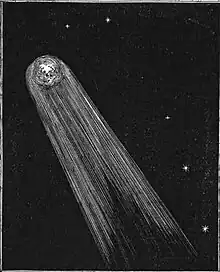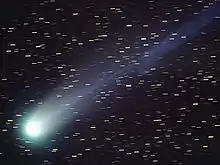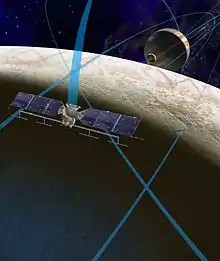 Sketch of 13P/Olbers on 14 October 1887 by William Robert Brooks | |
| Discovery | |
|---|---|
| Discovered by | Heinrich Olbers |
| Discovery date | March 6, 1815 |
| Designations | |
| 1815 E1; 1887 Q1; 1887 V; 1887f; 1956 A1; 1956 IV; 1956a | |
| Orbital characteristics | |
| Epoch | 2024-06-19 (JD 2460480.5)[1] |
| Aphelion | 32.56 AU |
| Perihelion | 1.175 AU |
| Semi-major axis | 16.87 AU |
| Eccentricity | 0.9303 |
| Orbital period | 69.3 yr 68y 11d (perihelion to perihelion) |
| Inclination | 44.67° |
| 85.8° | |
| Argument of periapsis | 64.4° |
| Last perihelion | June 19, 1956[2] |
| Next perihelion | June 30, 2024[3][1][2] |
| Earth MOID | 0.466 AU |
| Jupiter MOID | 0.692 AU |
| Comet total magnitude (M1) | 6.9 [4] |
13P/Olbers is a periodic comet with an orbital period of 69 years. It fits the classical definition of a Halley-type comet with (20 years < period < 200 years).[4] The comet had last been seen in 1956 and the next perihelion is on 30 June 2024.
Observational history
Discovery
Heinrich Wilhelm Matthias Olbers discovered the comet on 6 March 1815 and descripted it as small. The comet came to perihelion on 26 April 1815 and reached an apparent magnitude of about 5,[5] and was faintly visible by naked eye.[6] Its orbit was first computed by Carl Friedrich Gauss on March 31 as parabolic, and Friedrich Bessel calculated an orbital period of 73.9 years using observations from June. Calculations by other astronomers during that era resulted anywhere between 72 and 77 years.[5] Modern solutions give an orbital period of 74.9 years for the 1815 epoch.[1]
1887
| Orbital period at different epochs[7] | |||||||
| Epoch | Orbital period (years) | ||||||
|---|---|---|---|---|---|---|---|
| 1887 | 72.37 | ||||||
| 1956 | 69.54 | ||||||
| 2024 | 69.25 | ||||||
| 2094 | 70.72 | ||||||
There were unsuccessful searches for the comet throughout 1887, until it was accidentally found by William Robert Brooks on 25 August 1887.[5] He descripted as an easy object to see through a 9-inch reflector, with brightish nucleus and a faint tail and continued to brighten until a few days after passing perihelion.[8] The comet brightened to an apparent magnitude of about 9.[6] On 28 July 1887 the comet passed 0.081 AU (12.1 million km) from Mars and then passed perihelion on 8 October 1887.[7]
1956
The comet was recovered on 4 January 1956 by Antonín Mrkos. The comet was then located in Eridanus and its apparent magnitude was estimated to be 16. He then found the comet in plates obtained by the McDonald Observatory on 12 November 1955.[6] The comet passed perihelion on 19 June 1956 and reached an apparent magnitude of 6.5, while its tail was about one degree long.[5]
2024
The comet was recovered on 24 August 2023 by Alan Hale with the Las Cumbres Observatory at Siding Spring, and then additional pre-recovery images from August 13 where located. The comet then had an estimated apparent magntitude of about 22.[7][1] On 16 November 2023 the comet came to opposition 139 degrees from the Sun. It will then come to perihelion on June 30, 2024,[3] when it will be 1.18 AU from the Sun and 1.94 AU from Earth.[3] It is expected to brighten to about apparent magnitude 7−8.[2]
| Date | Distance (AU) | Solar elongation |
|---|---|---|
| 2024-Jul-20[9] | 1.895 AU (283.5 million km) | 35° |
| 2094-Jan-09[10] | 0.676 AU (101.1 million km) | 134° |
2094
Before the 2023 recovery, while the last observation was in 1956, Kinoshita calculated that the comet would come to a future perihelion passage (closest approach to the Sun) on 22 March 2094.[11] Accounting for observations in 2023, the nominal time of perihelion passage is now calculated to be 15 March 2094.[12]
There is some speculation that 13P/Olbers has an associated meteor shower on Mars coming from the direction of Beta Canis Majoris.[13]
References
- 1 2 3 4 MPC
- 1 2 3 Seiichi Yoshida (2004-07-31). "13P/Olbers". Seiichi Yoshida's Comet Catalog. Retrieved 2010-02-24.
- 1 2 3 "Horizons Batch for 13P/Olbers (90000226) on 2024-Jun-30" (Perihelion occurs when rdot flips from negative to positive). JPL Horizons. Archived from the original on 2022-06-15. Retrieved 2023-08-28. (JPL#11 Soln.date: 2023-Aug-28)
- 1 2 "JPL Small-Body Database Browser: 13P/Olbers". Jet Propulsion Laboratory. Retrieved 2012-07-26.
- 1 2 3 4 Kronk, Gary W. (2001–2005). "13P/Olbers". Retrieved 2012-02-22. (Cometography Home Page)
- 1 2 3 Roemer, Elizabeth (1956). "Comet Notes". Publications of the Astronomical Society of the Pacific. 68 (401): 171–172. ISSN 0004-6280.
- 1 2 3 "CBET 5289 : COMET 13P/OLBERS". Central Bureau for Astronomical Telegrams. 2023-08-28. Retrieved 2023-08-29.
- ↑ Brooks, W. R. (1 January 1888). "The Olbers-Brooks Comet". The Observatory. 11: 90–91. ISSN 0029-7704.
- ↑ "Closest Approach to Earth around 20 July 2024" (Closest Earth approach occurs when deldot flips from negative to positive). JPL Horizons. Retrieved 2023-08-28.
- ↑ "Closest Approach to Earth around 9 January 2094" (Closest Earth approach occurs when deldot flips from negative to positive). JPL Horizons. Retrieved 2023-08-28.
- ↑ Kinoshita, Kazuo (2003-02-25). "13P/Olbers past, present and future orbital elements". Comet Orbit. Retrieved 2023-08-28.
- ↑ "Horizons Batch for 13P/Olbers (90000226) for March 2094" (Perihelion occurs when rdot flips from negative to positive). JPL Horizons. Archived from the original on 2023-08-29. Retrieved 2023-08-28.
- ↑ "Meteor Showers And Their Parent Bodies". Archived from the original on 2008-10-03. Retrieved 2006-12-30.

.png.webp)
